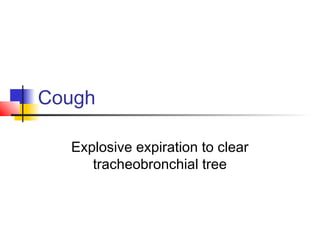
Cough & hemoptysis & cyanosis & clubbing
- 1. Cough Explosive expiration to clear tracheobronchial tree
- 2. Mechanism Voluntary or reflexive Phases- Deep inspiration Glottic closure & muscle contraction Glottis opens causing forced exhalation Stimuli- Inflammatory- infection, postnasal drip, GERD Mechanical- dust, tumors, edema, interstitial fibrosis Chemical- smoke, fumes Thermal- cold/hot air
- 3. Evaluation of cough Acute <3 wks. or Chronic >8 wks. Ac.- RTI; Ch.- postnasal drip, asthma, GERD Fever- present or absent Dry or productive; character of sputum Hemoptysis +/- Postural or diurnal or seasonal variation Associated symptoms- SOB/DOE, heartburn Past history of episodes of cough Personal history- smoking etc.
- 4. Evaluation- contd. Examination- oral cavity, larynx, rhonchi or crepts Investigation- need based Eosinophilia Sputum exam. ± culture, ± cytology CxR Spirometry CT scan Bronchoscopy
- 5. Investigation mandatory Hemoptysis Recurrent cough Rhonchi or crepts Any change in ‘smoker’s cough’
- 6. Complications of cough Syncope Insomnia Vomiting Subconjunctival hemorrhage Costochondritis Rib fracture Pneumothorax Hernia/Prolapse
- 7. Treatment Etiology based Stop ACEI Antacids/H2RB/PPI Antibiotics- bacterial infection Inhaled bronchodilators/steroids Symptomatic- dry cough only Cough suppressant- codeine/dextromethorphan Humidification & expectorants
- 8. Hemoptysis Blood in sputum streaking or gross
- 9. Hemoptysis- causes RTI- commonest TB Lung cancer Bronchiectasis Lung abscess Mitral stenosis Heart failure Pulmonary embolism Foreign body Trauma Wegener’s Goodpasture’s syn. Bleeding diathesis
- 10. Hemoptysis- evaluation A.B.C.- massive hemoptysis History Examination CxR- AP & lateral CT scan ± HRCT Bronchoscopy Echocardiography
- 11. Treatment Majority stops spontaneously Cough suppressants, if required Treat underlying pathology If massive or unresolving Angiography arterial embolization Bronchoscopy Surgery
- 12. Cyanosis Bluish color of skin/mucous membranes, due to >5 gm./dl. deoxygenated Hb.
- 13. Cyanosis- types Central Skin & mucous membranes Caused by decreased arterial oxygen sat. or abnormal hemoglobin Exposed areas warm Clubbing may be present Peripheral Peripheral exposed skin only Caused by vasoconstriction or decreased blood flow Exposed areas cold, massage/warming helps No clubbing
- 14. Cyanosis- causes Central- High altitude- decreased atmospheric pressure Bronchospasm, hypoventilation Congenital heart disease- TOF Intrapulmonary fistula/shunts Met/Sulf-hemoglobinemia Peripheral- low cardiac output cold exposure arterial/venous obstruction
- 16. Clubbing Drumstick finger Cause- vasodilation, PDGF, PGE2
- 17. Stages of clubbing 1- nail bed fluctuation 2- loss of angle between nailbed & fold 3- increased convexity of nail fold 4- thickened distal phalanx 5- hypertrophic osteoarthropathy Schamroth’s window test
- 18. Clubbing- causes Lung Cancer ILD TB Abscess Bronchiectasis Empyema Mesothelioma Cyanotic heart dis. SABE Atrial myxoma IBD PBC Hyperthyroidism Idiopathic
- 19. Management History Examination Investigation CxR CT scan ECHO Treatment- of underlying etiology
